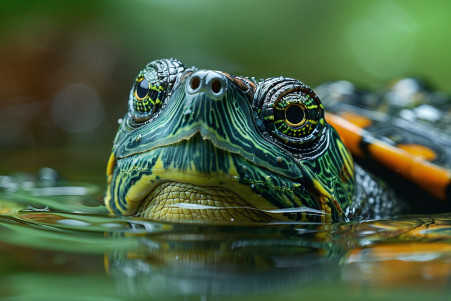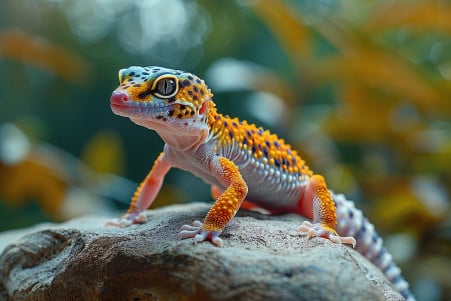How Long Can Turtles Go Without Eating? What You Need to Know About Their Dietary Resilience
10 February 2024 • Updated 11 February 2024

Turtles are often thought of as resilient animals, but how long can they go without eating? In the wild, and assuming they have access to water and the right temperatures, turtles can go for several months without eating. However, if you have a pet turtle, you should never let them go without food for more than a few weeks as it can cause a number of health problems.
This article will take an interdisciplinary approach that combines research from herpetology, animal physiology, and ecology to determine the various factors that impact how long turtles can survive without eating.
By looking at metabolic adaptations, hibernation behaviors, nutritional stores, and environmental factors, we hope to provide a comprehensive understanding of the many reasons why turtles are able to go without food for such long periods of time. Our hope is that this will help to demystify the science behind turtles’ periods of fasting and provide helpful information for both pet owners and nature lovers.
How long can turtles go without eating?
The Biological Mysteries Behind Turtles’ Ability to Survive Fasting
Turtles have developed some pretty incredible metabolic adaptations to survive long periods of fasting. One of the most important adaptations is their ability to maintain constant levels of ATP and ADP, the molecules that provide energy for cells, even during anoxic conditions—when they are deprived of oxygen.
As described in PubMed, studies have shown that unlike mammals, turtles can survive weeks of anoxia without oxidative damage upon reoxygenation. This is due to their constant ATP levels and lower accumulation of succinate, a molecule that can lead to oxidative stress when oxygen levels return to normal.
This is backed up by a study published in the Journal of Experimental Zoology, which found that red-eared slider turtles maintain their metabolic responses even after long periods of fasting, indicating that despite a loss of body mass, these turtles can recover metabolically from fasting as if they had been eating regularly.
In addition, a study in Zoological Science has shown that different species of turtles, including green sea turtles and Kemp’s ridley sea turtles, have different metabolic adaptations, including changes in their plasma thyroid hormone levels, which are known to be sensitive to food availability.
This shows the complex interplay between fasting and metabolic rate in these animals, and opens the door to understanding how their natural state of brumation – a type of hibernation – helps them survive periods of food scarcity.
Hibernation in Turtles and Fasting
When the weather gets colder and food becomes scarce, many turtles go into a state of brumation, which is often described as a reptilian version of mammalian hibernation. However, while hibernation is characterized by deep sleep and a significant drop in body temperature, reptilian brumation enables a more alert state of dormancy. While their metabolism slows and they rely on their fat stores, turtles can still move around.
Different species of turtles have different brumation patterns. For example, some turtles, like the Horsfield’s tortoise, may spend most of the year in brumation and only come out for a few months to make sure they can get enough water and food, according to Paula Morris.
The need for turtles to fast before hibernation to clear their digestive tracts and avoid infections during brumation is emphasized by Brock Yates. This way, turtles can minimize their need for food during the colder months.
It’s important to make sure pet turtles are hibernated responsibly. This means giving them a full health check before they go into brumation and maintaining a consistent temperature, which is typically between 39°F and 50°F, according to Paula Morris. It’s also important to monitor weight loss and signs of dehydration to make sure turtles are healthy when they come out of brumation.
The detailed and cautious approach to turtle brumation shows the complex interplay of physiological changes that make it possible for these animals to survive long periods of fasting. This natural adaptation, when combined with our knowledgeable intervention, makes it possible for turtles to adapt to different environments, which further demonstrates their amazing resilience.
Nutritional Reserves and Energy Expenditure in Turtles
When fasting, turtles rely on their nutritional reserves, mainly fat and glycogen, to fuel their metabolic processes.
One study of the eastern long-necked turtle by John H. Roe found that the rate of energy expenditure decreases as the duration of terrestrial estivation increases, which means that the turtles are drawing on their fat reserves more slowly to avoid running out of energy too quickly.
The effect of fasting on turtles’ energy and water balance is important. Roe found that estivating turtles can come close to maintaining water balance, although they do lose water over time, showing that water is just as important as food in terms of how long they can fast.
Meanwhile, a study by Mateusz Rawski and colleagues offered a detailed look at the nutritional requirements of freshwater turtles, and it showed that a well-rounded diet that includes the right amounts of protein, fat, and essential nutrients is essential to building up these reserves.
For pet turtles, this means that it’s important to make sure they have built up these reserves through a well-rounded diet before any fast.
By making sure that pet turtles have the reserves they need, including fat and glycogen, owners can help ensure that their pets can survive a fast without any serious health issues. As a result, understanding and meeting the nutritional needs of turtles is essential to their ability to survive a lack of food.
How the Environment Impacts the Length of Time Turtles Can Fast
The environment is a major factor in how long turtles can go without food. Different ecosystems present different challenges and resources, which can impact how turtles will fare during periods of fasting. For example, aquatic turtles may rely on the water temperature, which can impact their metabolic rate.
A study in PMC found that short-term fasting does not impact the performance of certain activities in post-hatchling green turtles, which suggests that they are adapted to the resources and temperatures of the aquatic environment.
Temperature changes are especially important. A study in PubMed found that in the red-footed tortoise, energy requirements and utilization change with ambient temperature, which in turn impacts their growth and metabolic rates. This means that turtles in colder environments may have slower metabolisms and, therefore, longer fasting times.
Moreover, it is important to take into account the impact of global warming on turtles’ fasting times. As the climate changes, it may impact how long turtles can fast and how many will survive, which will require more research into how turtles will adapt to these changes. This information is important in understanding the balance between turtles and their environment, which will impact how well they survive periods of food scarcity.
Behavioral Adaptations of Turtles During Times of Scarcity
In times of food scarcity, turtles have been shown to make some pretty incredible behavioral adaptations to save energy.
One of the most common ways that turtles save energy is by reducing their activity levels, and these levels change based on the resources that are available.
For example, a study of green turtles found that during the austral winter, turtles increased their dive durations, which the researchers suggested was a way to save energy when food is less available.
In addition, turtles’ social behaviors can change in response to competition for food. A study published in ScienceDirect found that more aggressive sea turtles are more likely to win contests for foraging resources. This shows that social interactions can play a role in a turtle’s ability to find food, which is especially important in times of scarcity.
The study also showed that turtles are able to more efficiently manage their energy during these times. For example, the researchers used body acceleration data to estimate energy expenditure and found that turtles may adjust their swimming and foraging behavior to minimize energy expenditure when food is scarce.
As turtles face the difficulties of food scarcity, their ability to manage their energy becomes key to their survival. The interaction of behavioral, social, and physiological adaptations helps ensure that turtles can make it to their next meal, demonstrating their ability to adapt to environmental challenges.
What Turtles Can Teach Us About Resilience
In conclusion, after exploring the fascinating world of turtles, their ability to survive long periods without food is a clear example of their resilience. The metabolic changes that turtles undergo, their ability to store and use energy effectively, and their contribution to hibernation or brumation are all key components of their survival.
These physiological and behavioral adaptations have evolved in a way that is highly specific and tailored to the turtle’s environment.
It is also important to note that while these adaptations have helped turtles survive in the wild, it is important for pet owners to make sure that their pet turtles are not forced to fast for long periods of time, as it can have negative health consequences.
Instead, pet owners should make sure that their turtles are eating a balanced diet that will help them build up the energy reserves they need to fast when it is necessary in the wild.
Ultimately, turtles are a great example of survival and resilience. As they continue to adapt to changing environments and the availability of resources, their ability to survive and thrive is a clear demonstration of their resilience. Their ability to live in a variety of environments also offers important lessons about resilience and the importance of allowing and supporting the natural adaptations of these incredible animals.


